 Richard Whelan: His Master’s Voice
Richard Whelan: His Master’s Voice
“Writing the hagiography of a saint is simple, exploring the profound contradictions in a flawed man is an act of true education.” — NYC high-school English teacher Chris Van Dyke, “As a Teacher, the New Atticus Gives Students More to Wrestle With,” New York Times, July 15, 2015
Cornell Capa, seeking a compliant authorized biographer for his brother, needed a hagiographer rather than a truly independent scholar. He’d already had experience with the latter — Jozefa Stuart, whom he’d commissioned for that task circa 1960. Stuart had done important spadework, but eventually ran afoul of Cornell’s insistence on controlling the Robert Capa narrative. So Cornell set that project aside for well over a decade. Returning to it in the late 1970s, he chose wisely when he settled on Richard Whelan. Unlike Stuart, Whelan came on board fully prepared to do as told.
Over the course of this investigation I have pointed to a wealth of errors, elisions, misdirections, and outright lies in Whelan’s publications about Robert Capa. His obfuscations found their full expression in his varied and increasingly desperate rationales for the supposed authenticity of Capa’s iconic 1936 image from the Spanish Civil War, “Falling Soldier.”
By the time Whelan hired himself out to Cornell Capa and the Robert Capa estate, circa 1980, Phillip Knightley had already challenged the credibility of “Falling Soldier” in his 1975 book The First Casualty: The War Correspondent as Hero and Myth-Maker from the Crimea to Iraq. Whelan’s commission as Capa’s official biographer, then, included the imperative of publicly contesting an already controversial image very much in need of high-visibility defense. Whelan undertook that task enthusiastically, as detailed in my previous post.
At the time he engaged Whelan to write his brother’s biography, Cornell Capa certainly knew that Robert had faked that image; to assume otherwise involves believing that Robert confided secrets to friends — LIFE photographers Otto Hagel and Hansel Mieth — that he would not share with his own brother. Whether Cornell told Whelan the truth from the outset or not, we know that by 1982 the biographer, and his patron, had learned it from Mieth.
We also know that, as previously disclosed here, Cornell knew the true story of Robert’s D-Day experiences and the fate of his Omaha Beach negatives. Whether or not he kept that information from Whelan, the biographer had at his disposal the very same primary materials on which our team has drawn for our deconstruction of that myth. To assume that Whelan failed to put those pieces together while working daily for years with the same hard evidence is to judge him incompetent in his discipline, which I do not believe was the case.
So if Whelan’s commission charged him explicitly with covering up the “Falling Soldier” fakery, already a matter of public dispute, it mandated implicitly a comparable camouflage of the truth about the D-Day images and their contextualizing narrative — though these, at the moment he began his work, had not come under scrutiny or faced public challenge. Whelan handled that preemptive component of the project with the same alacrity he exhibited in validating and valorizing “Falling Soldier.”
The Flim-Flam Man
As a prime example of skillful scholarly rope-a-dope, consider this passage from the D-Day chapter of Whelan’s 1985 Capa biography:
Capa, assigned to the 1st Infantry Division’s 16th Regiment … proceeded … to Weymouth [a port on the coast of England]. There, in the gymnasium of the Coast Guard transport Samuel Chase, the regiment’s headquarters ship, he found the unit’s officers studying a giant sponge rubber model of the section of the beach code-named “Omaha” … Capa decided to go with Company E of the 2nd Battalion, which was to spearhead the landings on the section of Omaha Beach designated “Easy Red” and push inland to the village of Colleville-sur-Mer. … [H]e would be right beside the first Allied troops landing in France.
At 3 a.m. on D-Day (Tuesday, June 6), by which time the armada had arrived off the Norman coast, a big breakfast … was served on board the U.S.S. Henrico, the 2nd Battalion’s transport ship. Half an hour later Company E was called to its debarkation station, and at 4:15 the landing craft were lowered into the rough sea for the twelve-mile trip to the beaches. … (Richard Whelan, Robert Capa: A Biography, 1985, pp. 210-211.)
So Whelan begins by placing Capa aboard the U.S.S. Samuel Chase, where the 1st Infantry Division’s 16th Regiment, to which he had been assigned, had its headquarters. Whelan has no choice in the matter; not only did Capa put himself there in his memoir, but friends of his in the military command have independently recalled his presence there the night of June 5, before D-Day, playing poker with the officers.
But that creates a problem, because the troops from this regiment that hit Omaha Beach in the first wave did not come from the Chase, but from the U.S.S. Henrico. The troops from the Chase, including the command staff, came ashore in a later wave. So — without actually stating that Capa somehow changed ships during the crossing (an impossible feat in the darkness, with the 5000-vessel armada under blackout conditions and radio silence) — Whelan simply switches to the 3 a.m. breakfast scene aboard the Henrico, describing in detail that meal and the subsequent loading into their boats of the troops from Company E, then their final trip through rough seas to the beach.
He does this, slyly, without mentioning Capa once. Then he segues, “When Capa ran down the ramp of his landing craft and into the waist-deep water, he found that …,” followed by a quote from Capa’s memoir: “The water was cold, and the beach still more than a hundred yards away. The bullets tore holes in the water around me, and I made for the nearest steel obstacle.”
Without once saying so, this carefully constructed narrative implies that Capa landed with those first-wave Company E troops from the Henrico. Caught up in the story, the reader is unlikely to notice or question the venue switch from the Chase to the Henrico, which the myth requires. (My thanks to Charles Herrick for pointing out this particular bit of flim-flam.)
Upping the Ante
This sets the stage for the following passage from Whelan’s catalog for the 2007 ICP show “This Is War! Robert Capa at Work,” referring to “Capa’s caption notes made aboard the U.S.S. Henrico“:
“[B]efore he left the Henrico on D-Day morning he entrusted all the rolls of film that he had shot until then to a ship’s officer to relay back to London. The films were developed and passed by the censor during D-Day.” (p. 224)
This absolutely contradicts not only Capa’s own version but both John Morris’s original account and what Morris calls his “new theory.” No single shred of evidence supports the confabulation. Capa neither sailed on nor transferred to the U.S.S. Henrico during the invasion.
Among other improbabilities, this scenario would have required that newly introduced “ship’s officer” — who surely had more important things to do — to somehow get those films across the English Channel and thence to London on D-Day. If he did so, Morris had to have the London lab develop and print these B-roll images, caption them, and then — although anxiously awaiting word from Capa and delivery of his crucial Omaha Beach documentation — to leave LIFE‘s London office in the middle of D-Day in order to drive though heavy London traffic to the censors’ office. Once there, he would certainly have discovered that the censors had orders not to pass through any images of the invasion until SHAEF had some idea of the outcome of the initial landing. After that, Morris would have to race back through the same heavy traffic to the office, where Capa’s films of the fighting could have sat for hours on his desk — only to repeat that run the next morning. Why on earth would he do that?
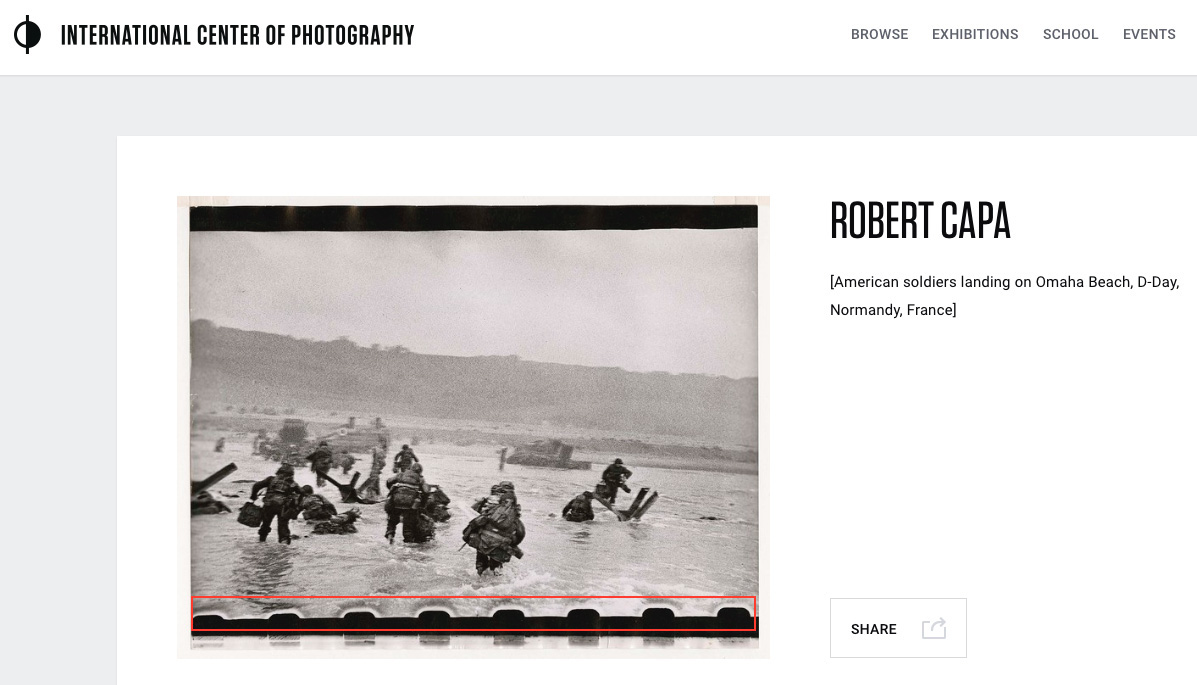
Screen shot of Capa D-Day contact print from ICP website, showing sprocket-hole intrusion (indicated in red).
Not satisfied with setting forth this nonsense and repeating the baseless fable of the accident in LIFE‘s London darkroom, Whelan actually elaborates it further, proposing for the first time, in This Is War!, that the overlap of the image area onto the sprocket holes in Capa’s ten Omaha Beach negatives serves as evidence of emulsion slide during the fictive darkroom disaster. He makes not even a pretense of sourcing any of that — which is an outright lie, as the negatives and contact sheets in the Capa Archive at ICP prove, as Whelan surely knew, and as Rob McElroy demonstrated inarguably in this post.
•
Another example: On p. 234 of This Is War! Whelan reproduces (as Fig. 295) a detail from Capa’s negative 35, the one showing the engineers at work. Whelan writes,
“Another tentative identification has recently been made concerning Capa’s photograph of men crouching by a hedgehog at water’s edge (Fig. 291). The soldier furthest to the left in the photo is probably William P. Buell, who was in the 5th Engineers Special Brigade, attached to the 16th Regiment. According to his daughter, Private First Class Buell landed on Omaha Beach with the second wave. The half-moon insignia on his helmet confirms that the man in Capa’s photographs was indeed an engineer. That man seems to have the same broad nose that we see in a personal snapshot of Buell (figs. 295 and 296).”
So, while he managed to identify this figure (on the left) as an engineer, even provisionally naming him, it never occurred to Whelan to inquire as to what this engineer and the men next to him did at that hedgehog other than “crouching.” In fact, as Charles Herrick demonstrated in a post in this series, these very engineers had successfully demolished enough obstacles to allow incoming landing craft full access to the beach at Colleville-sur-Mer, enabling one of the Allies’ crucial breakthroughs to the top of the bluffs on the far side of the beach.
Whelan also slides right past the challenge to Capa’s own narrative of his actions that day (and Whelan’s parroting thereof) posed by the statement that “Private First Class Buell landed on Omaha Beach with the second wave.” Capa’s fourth exposure of the ten he made on Easy Red shows that same group of engineers seen from the rear (in the lower center of his frame), as Capa approached them after disembarking from the LCVP that brought him there.
Briefly put, if Capa came in with the first wave, as he himself claimed and as everyone claims for him (including Whelan and John Morris), how could his seventh exposure that morning, made just minutes after disembarking from the LCVP that brought him there, show a soldier who came in with the second wave, already hard at work — not to mention the waves of soldiers and armored vehicles who had obviously preceded Capa?
Additionally, in order to reconcile various otherwise insupportable assertions, Whelan (though first indicating that Capa landed, as he himself claims, on the Easy Red sector of Omaha Beach), inexplicably thereafter refers to him as present on the Fox Green sector. This enables him to have Capa land with the first wave of combat troops from Company E, coming in from the Henrico; to connect Capa to Huston “Hu” Riley, considered in 2007 as definitively the subject of “The Face in the Surf,” Capa’s penultimate Omaha Beach exposure; and to put him in the path of LCI(L)-85, on which Whelan argues that Capa departed.
Indeed, he proposes that Capa left Fox Green on that severely damaged vessel, returned to the Chase, took another LCVP back to the beach, and then caught LCI(L)-94 back to the Chase. Unfortunately, beyond its impossibility as a timeline, this convoluted rigmarole requires the biographer to disregard both Capa’s own account and the hard evidence of his handful of photographs from the beach, which show beyond question that he landed in the Easy Red sector.
•
Regrettably, such illogic, elision of inconsistent evidence, and inattention to detail typify Whelan’s approach to scholarship. By the end of his life he had become little more than a liar for hire, committed to truthiness rather than truth, churning out junk like this in order to save the appearances by shoring up the Capa myth and explaining away the contradictions that had begun to surface.
Unless and until some dedicated independent scholars go through Whelan’s research materials and produce annotated versions of his biography and other publications, Whelan’s work on all matters related to the subjects of Robert and Cornell Capa should be considered fatally compromised and entirely unreliable, except when their overall narratives and specific claims can be verified by credible outside sources. Certainly we cannot consider his biography of Capa a trustworthy source. It will take decades to undo the contamination of the literature on Robert Capa that traces directly to Whelan’s efforts on Cornell Capa’s behalf.
Thou Good and Faithful Servant
In his relation to the life and work of Robert Capa, Richard Whelan had one overriding obligation: protecting the brand. This included ensuring that no one could challenge his positions, by securing all Capa-related documentation in the possession of Cornell Capa and/or ICP against independent researchers like Alex Kershaw, as detailed in previous posts.
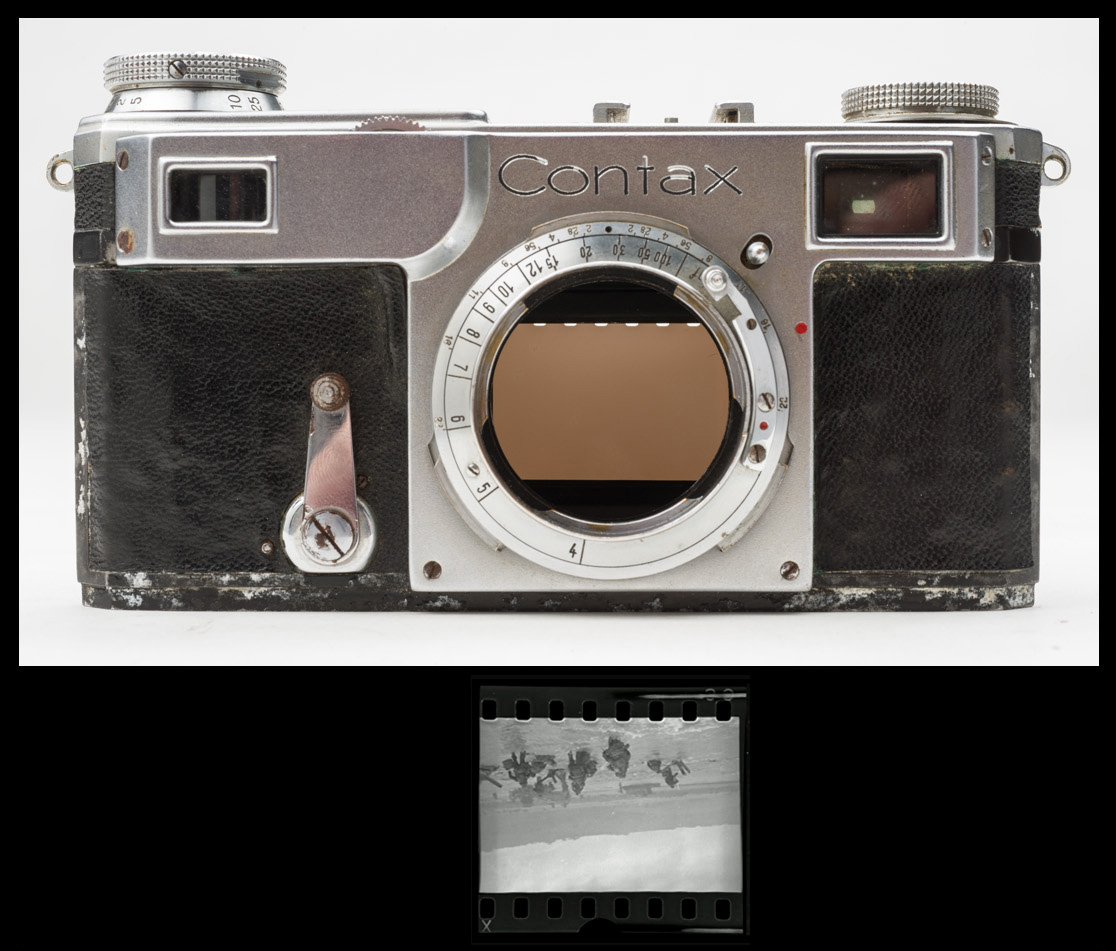
Top: Contax camera loaded with shorter Kodak cassette showing sprocket holes being exposed. Bottom: Capa negative shown with proper orientation as it would have appeared in the camera. Note exposed sprocket holes. Top photo © 2015 by Rob McElroy.
Alienated from his own family when he came out of the closet in the second half of the 1970s, Whelan had struggled for much of his life with alcoholism and depression. According to people who knew him well, both conditions were peaking (again) in the months before he killed himself on May 23rd, 2007, as he was wrapping up the “This Is War!” exhibition and monograph project.
Read autobiographically, as a summation of Whelan’s 27-year involvement in Capa research, This Is War! is a sad book — at once a confession of a quarter-century’s corrupted scholarship and a continuation thereof. The catalog reiterated what Whelan knew were falsehoods about “Falling Loyalist” and the D-Day narrative, adding new fabrications to those. Only in mid-2007, with Cornell Capa’s health failing and Whelan apparently planning to predecease his disclosure, did he break his silence and retract the most egregious of his extravagant claims concerning the credibility of Capa’s “Falling Soldier.”
Unless a farewell note surfaces, we’ll likely never know to what extent the burden of his own intellectual and professional corruption contributed to the state of mind that led Whelan to end it all. Regardless of that, he leaves behind a tainted legacy at ICP that only the institution’s embrace of truly independent scholarship can cleanse.
•
(For an index of links to all posts in this series, click here.)
•
 Special offer: If you want me to either continue pursuing a particular subject or give you a break and (for one post) write on a topic — my choice — other than the current main story, make a donation of $50 via the PayPal widget below, indicating your preference in a note accompanying your donation. I’ll credit you as that new post’s sponsor, and link to a website of your choosing. Include a note with your snail-mail address (or email it to me separately) for a free signed copy of my 1995 book Critical Focus!
Special offer: If you want me to either continue pursuing a particular subject or give you a break and (for one post) write on a topic — my choice — other than the current main story, make a donation of $50 via the PayPal widget below, indicating your preference in a note accompanying your donation. I’ll credit you as that new post’s sponsor, and link to a website of your choosing. Include a note with your snail-mail address (or email it to me separately) for a free signed copy of my 1995 book Critical Focus!


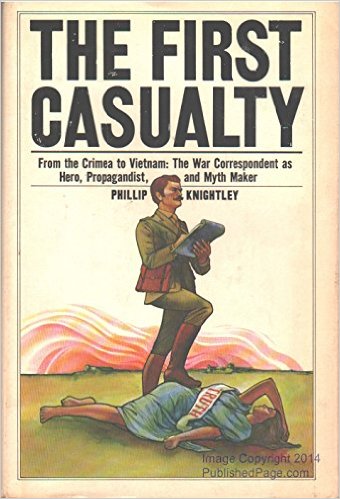
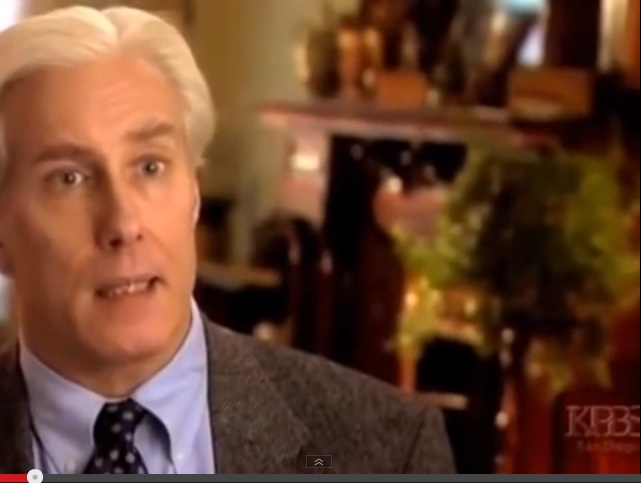
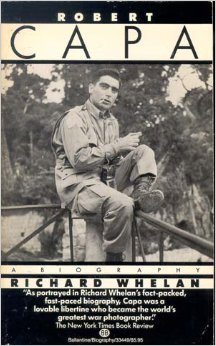
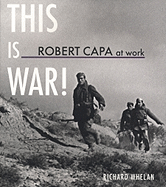
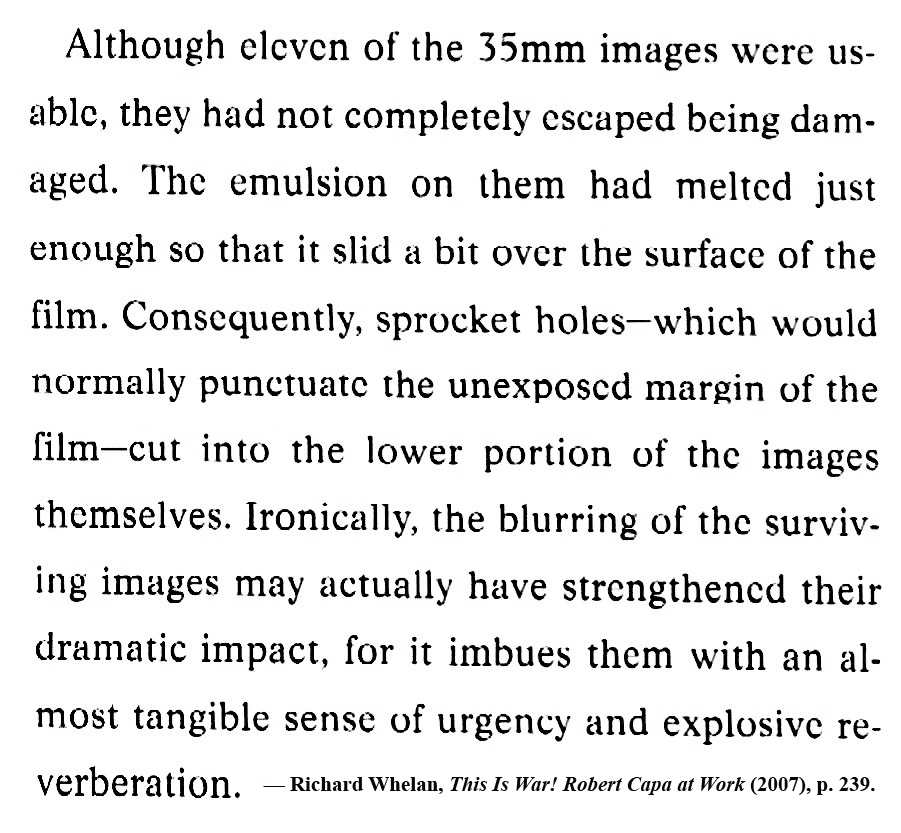
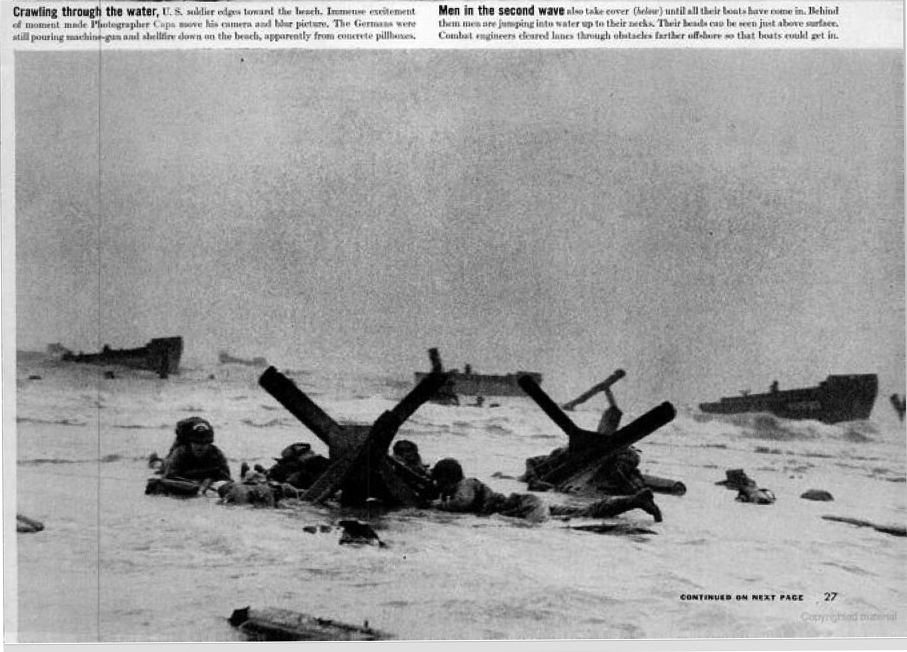
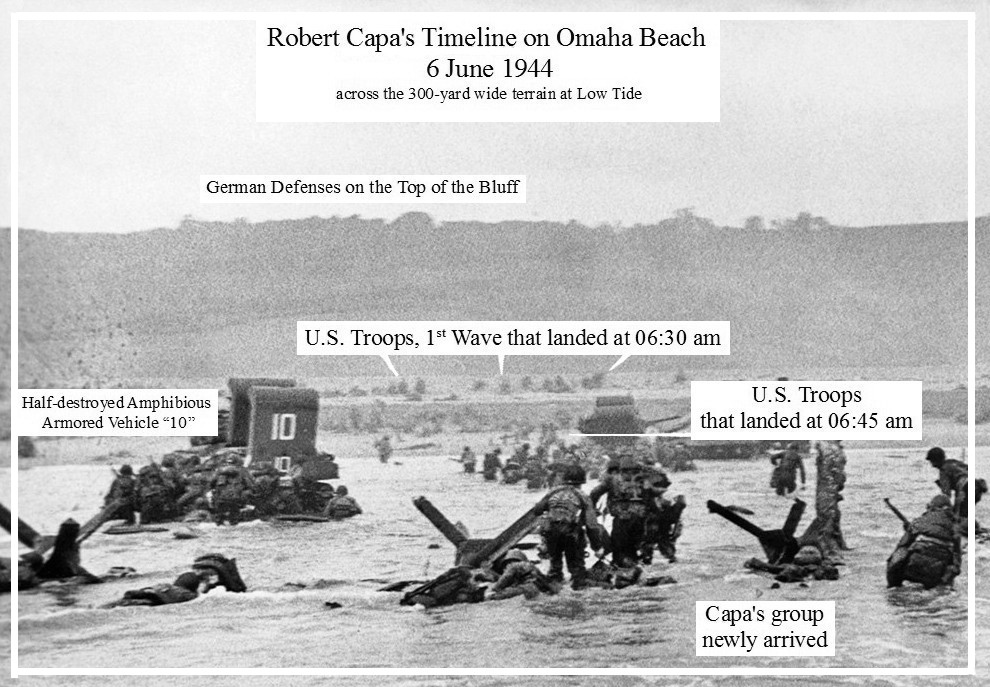
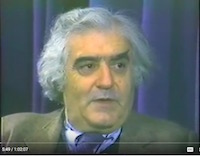




Leave a Comment